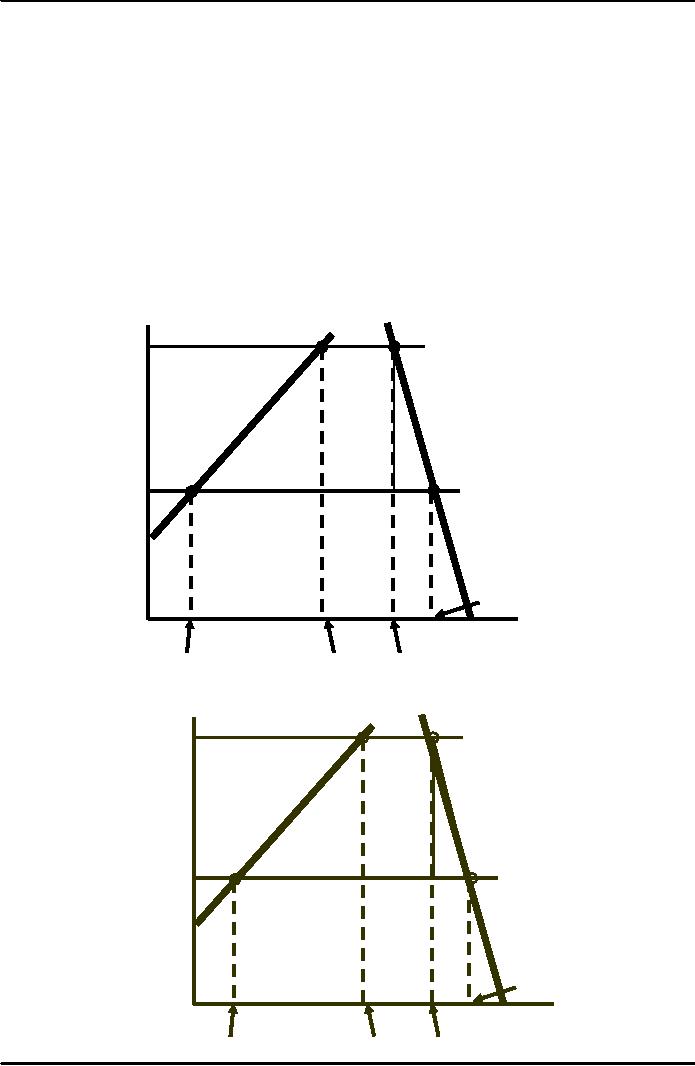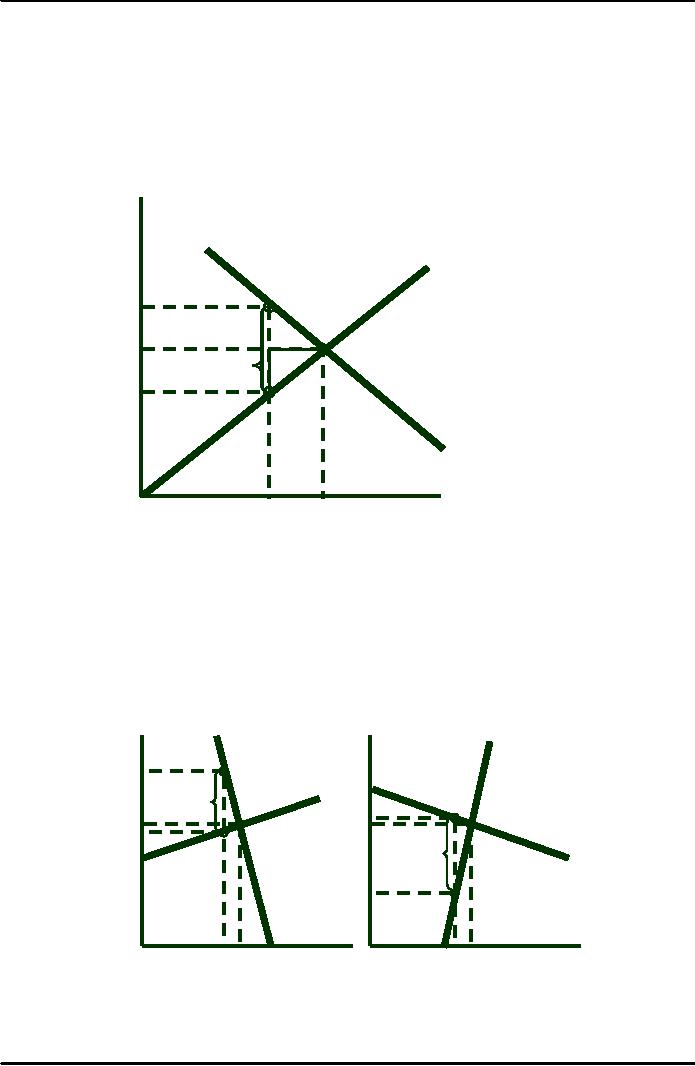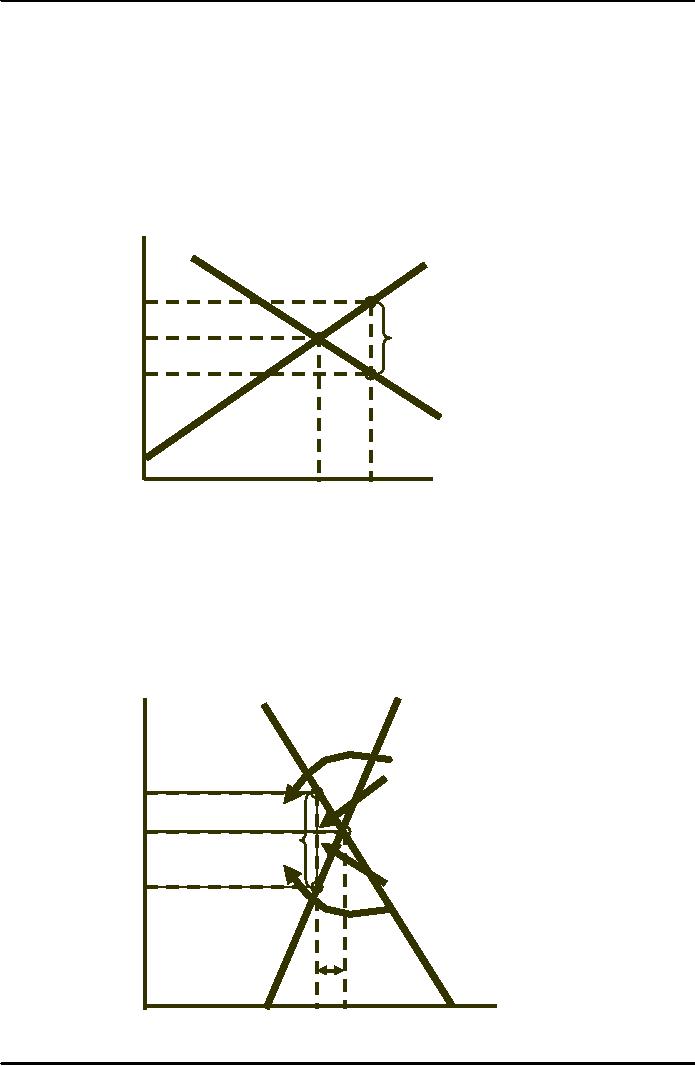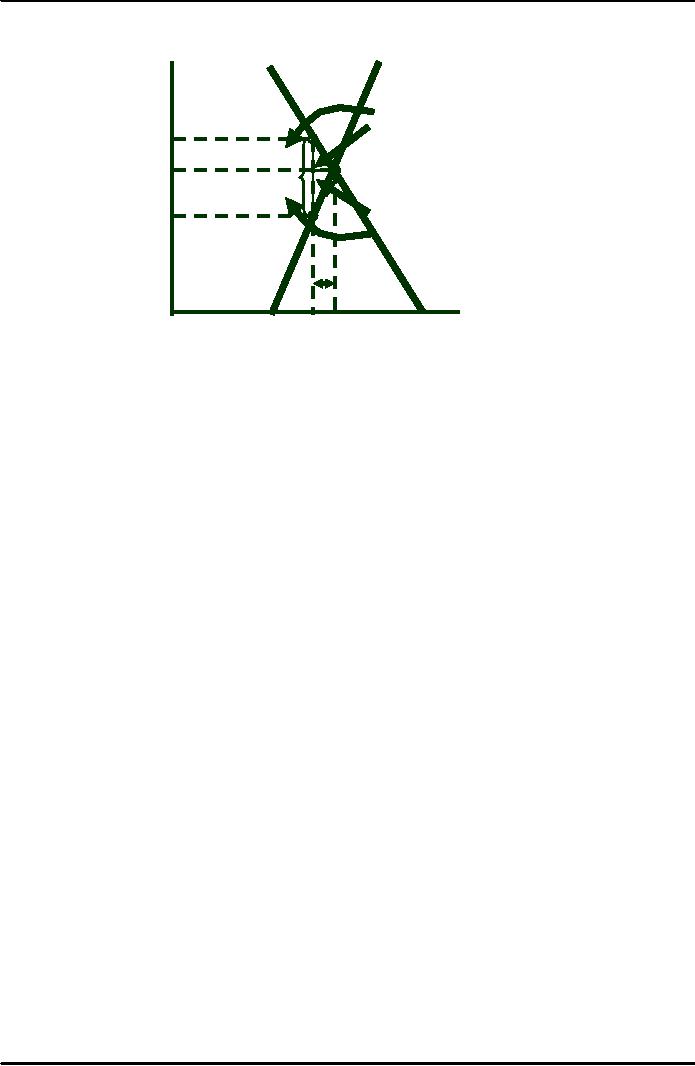 |
The Sugar Quota:The Impact of a Tax or Subsidy, Subsidy |
| << Price Supports:Supply Restrictions, Import Quotas and Tariffs |
| Perfect Competition:Total, Marginal, and Average Revenue >> |

Microeconomics
ECO402
VU
Lesson
29
The
Sugar Quota
The
world price of sugar has
been as low as 4 cents per
pound, while in the U.S.
the price
has
been 20-25 cents per
pound.
The
Impact of a Restricted Market
(1997)
U.S. production
= 15.6 billion pounds
U.S.
consumption = 21.1 billion
pounds
U.S. price = 22
cents/pound
World price =
11 cents/pound
Sugar
Quota in 1997
DUS
SUS
Price
PUS =
21.9
(cents/lb.)
D
The
cost of the quotas
20
to
consumers was
A
A
+ B + C + D, or
$2.4b.
The
gain to producers
16
was
area A,
or
$1b.
C
B
PW =
11
11
8
4
Qd =
24.2
30
0
5
10
15
20
25
Quantity
(billions
of pounds)
QS =
4.0
Q'S =
15.6
Q'd =
21.1
DUS
SUS
Price
PUS =
21.9
(cents/lb.)
D
Rectangle
D was
the
20
gain
to foreign producers
A
who
obtained quota
allotments,
or $600 million.
16
Triangles
B and
C represent
C
B
the
deadweight loss of
$800
million.
PW =
11
11
8
4
Qd =
24.2
0
5
30
10
15
20
25
Quantity
(billions
of pounds)
QS =
4.0
Q'S =
15.6
Q'd =
21.1
138

Microeconomics
ECO402
VU
The
Impact of a Tax or
Subsidy
The
burden of a tax (or the
benefit of a subsidy) falls
partly on the consumer and
partly on
the
producer.
We
will consider a specific tax
which is a tax of a certain
amount of money per unit
sold.
Incidence
of a Specific Tax
Pb is the
price (including
the
tax) paid by buyers.
Price
PS is the
price sellers receive,
net
of the tax. The
burden
of
the tax is split
evenly.
S
Pb
Buyers
lose A
+ B,
and
A
sellers
lose D
+ C, and
B
the
government earns A
+ D
P0
in
revenue. The
deadweight
D
C
t
loss
is B
+ C.
PS
D
Q1
Q0
Quantity
Four
conditions that must be
satisfied after the tax is
in place:
1.
Quantity sold and Pb must be on the demand
line: QD
= QD(Pb)
2.
Quantity sold and PS must be on the supply
line: QS
= QS(PS)
3.
QD =
QS
4.
Pb -
PS = tax
Impact
of Tax Depends on Elasticities of
Supply & Demand
Burden
on Buyer
Burden
on Seller
D
S
Price
Price
P
S
t
P
P
P
P
t
D
P
Q1 Q0
Q1 Q0
Quantity
Quantity
139

Microeconomics
ECO402
VU
The
Impact of a Tax or
Subsidy
Pass-through
fraction
ES/(ES -
Ed)
For example,
when demand is perfectly
inelastic (Ed
= 0),
the pass-through fraction is
1,
and
all the tax is borne by
the consumer.
A
subsidy can be analyzed in
much the same way as a
tax.
It
can be treated as a negative
tax.
The
seller's price exceeds the
buyer's price.
Subsidy
S
Price
Like
a tax, the benefit
PS
of
a subsidy is split
between
buyers and
s
P0
sellers,
depending
upon
the elasticities of
Pb
supply
and demand.
D
Q0
Q1
Quantity
With
a subsidy (s), the selling
price Pb is
below the subsidized price
PS so that:
s = PS -
Pb
The
benefit of the subsidy
depends upon Ed /ES.
If the ratio is
small, most of the benefit
accrues to the
consumer.
If the ratio is
large, the producer benefits
most.
Impact
of a $0.50 Gasoline
Tax
D
S
Price
($
per
gallon)1.50
Lost
Consumer
The
annual revenue
Pb =
1.22
from
the tax is .50(89)
A
or
$44.5 billion. The
buyer
pays
22 cents of the tax,
and
P0 =
1.00
the
producer pays 28
cents.
D
t = 0.50
Lost
Producer
PS =
.72
Surplus
.50
1
Quantity
(billion
0
50
60
89
100
150
gallons
per year)
140

Microeconomics
ECO402
VU
D
S
Price
($
per 1.50
gallon)
Lost
Consumer
Pb =
1.22
A
P0 =
1.00
Deadweight
loss = $2.75 billion/yr
D
t = 0.50
Lost
PS =
.72
Producer
.50
1
Quantity
(billion
0
50
60
89
100
150
gallons
per year)
141
Table of Contents:
- ECONOMICS:Themes of Microeconomics, Theories and Models
- Economics: Another Perspective, Factors of Production
- REAL VERSUS NOMINAL PRICES:SUPPLY AND DEMAND, The Demand Curve
- Changes in Market Equilibrium:Market for College Education
- Elasticities of supply and demand:The Demand for Gasoline
- Consumer Behavior:Consumer Preferences, Indifference curves
- CONSUMER PREFERENCES:Budget Constraints, Consumer Choice
- Note it is repeated:Consumer Preferences, Revealed Preferences
- MARGINAL UTILITY AND CONSUMER CHOICE:COST-OF-LIVING INDEXES
- Review of Consumer Equilibrium:INDIVIDUAL DEMAND, An Inferior Good
- Income & Substitution Effects:Determining the Market Demand Curve
- The Aggregate Demand For Wheat:NETWORK EXTERNALITIES
- Describing Risk:Unequal Probability Outcomes
- PREFERENCES TOWARD RISK:Risk Premium, Indifference Curve
- PREFERENCES TOWARD RISK:Reducing Risk, The Demand for Risky Assets
- The Technology of Production:Production Function for Food
- Production with Two Variable Inputs:Returns to Scale
- Measuring Cost: Which Costs Matter?:Cost in the Short Run
- A Firm’s Short-Run Costs ($):The Effect of Effluent Fees on Firms’ Input Choices
- Cost in the Long Run:Long-Run Cost with Economies & Diseconomies of Scale
- Production with Two Outputs--Economies of Scope:Cubic Cost Function
- Perfectly Competitive Markets:Choosing Output in Short Run
- A Competitive Firm Incurring Losses:Industry Supply in Short Run
- Elasticity of Market Supply:Producer Surplus for a Market
- Elasticity of Market Supply:Long-Run Competitive Equilibrium
- Elasticity of Market Supply:The Industry’s Long-Run Supply Curve
- Elasticity of Market Supply:Welfare loss if price is held below market-clearing level
- Price Supports:Supply Restrictions, Import Quotas and Tariffs
- The Sugar Quota:The Impact of a Tax or Subsidy, Subsidy
- Perfect Competition:Total, Marginal, and Average Revenue
- Perfect Competition:Effect of Excise Tax on Monopolist
- Monopoly:Elasticity of Demand and Price Markup, Sources of Monopoly Power
- The Social Costs of Monopoly Power:Price Regulation, Monopsony
- Monopsony Power:Pricing With Market Power, Capturing Consumer Surplus
- Monopsony Power:THE ECONOMICS OF COUPONS AND REBATES
- Airline Fares:Elasticities of Demand for Air Travel, The Two-Part Tariff
- Bundling:Consumption Decisions When Products are Bundled
- Bundling:Mixed Versus Pure Bundling, Effects of Advertising
- MONOPOLISTIC COMPETITION:Monopolistic Competition in the Market for Colas and Coffee
- OLIGOPOLY:Duopoly Example, Price Competition
- Competition Versus Collusion:The Prisoners’ Dilemma, Implications of the Prisoners
- COMPETITIVE FACTOR MARKETS:Marginal Revenue Product
- Competitive Factor Markets:The Demand for Jet Fuel
- Equilibrium in a Competitive Factor Market:Labor Market Equilibrium
- Factor Markets with Monopoly Power:Monopoly Power of Sellers of Labor